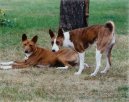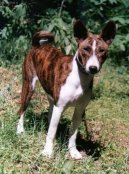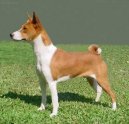Basenji (Dog standard)
Basenji is a lightly built, finely boned aristocratic looking animal, high on legs compared with its length, always poised, alert and intelligent.
FCI-Standard N° 43 / 24. 01. 2000 / GB
BASENJI
ORIGIN : Central Africa.
PATRONAGE : Great Britain.
DATE OF PUBLICATION OF THE ORIGINAL VALID STANDARD : 25.11.1999.
UTILIZATION : Hunting dog, companion.
CLASSIFICATION F.C.I. : Group 5 Spitz and primitive types.
Section 6 Primitive type.
Without working trial.
GENERAL APPEARANCE : Lightly built, finely boned aristocratic looking animal, high on legs compared with its length, always poised, alert and intelligent. Wrinkled HEAD, with pricked ears, proudly carried on a well arched NECK. Deep brisket runs up into a definite waist, TAIL tightly curled presenting a picture of a well balanced dog of gazelle-like grace.
IMPORTANT PROPORTION : Distance from top of HEAD to stop slightly more than from stop to tip of nose.
BEHAVIOUR / TEMPERAMENT : Barkless but not mute, its own special noise a mixture of a chortle and a yodel. Remarkable for its cleanliness in every way. An intelligent, independent, but affectionate and alert breed. Can be aloof with strangers.
HEAD : Fine and profuse wrinkles appearing on foreHEAD when ears pricked; side wrinkles desirable but not exaggerated into dewlap; wrinkles more noticeable in puppies, but because of lack of shadowing, not as noticeable in triCOLOURs.
CRANIAL REGION :
Skull : Flat, well-chiselled and medium width, tapering towards the nose. Side lines of skull taper gradually towards mouth, giving a clean-cheeked appearance.
Stop : Slight.
FACIAL REGION :
Nose : Black nose desirable.
Jaws/Teeth : Jaws strong with a perfect, regular and complete scissor bite, i.e. the upper teeth closely overlapping the lower teeth and set square in the jaws.
Eyes : Dark, almond-shaped; obliquely set, far-seeing and rather inscrutable in expression.
Ears : Small, pointed, erect and slightly hooded, of fine texture, set well forward on top of HEAD, tip of ear nearer centre of skull than outside base.
NECK : Strong and of good length, without thickness, well crested and slightly full at base of throat with a graceful curve accentuating crest. Well set into shoulders giving HEAD a « lofty » carriage.
BODY : Balanced.
Back : Short, level.
Loin : Short-coupled.
Chest : Deep brisket. Ribs well sprung, deep and oval.
Underline : Running up into a definite waist.
TAIL : High set, with posterior curve of buttock extending beyond root of TAIL giving a reachy appearance to HINDQUARTERS. Curls tightly over spine and lies closely to thigh with a single or double curl.
LIMBS
FOREQUARTERS : Forelegs straight with fine bone. Legs in a straight line to ground giving a medium front.
Shoulders : Well laid back, muscular, not loaded.
Elbows : Tucked in against brisket. When viewed from front, elbows in line with ribs.
Forearm : Very long.
Pasterns : Good length, straight and flexible.
HINDQUARTERS : Strong and muscular.
Stifle : Moderately bent.
Second thigh : Long.
Hock : Well let down, turned neither in nor out.
FEET : Small, narrow and compact, with deep pads, well arched toes and short nails.
GAIT / MOVEMENT : Legs carried straight forward with a swift, long, tireless, swinging stride.
SKIN : Very pliant.
COAT
HAIR : Short, sleek and close, very fine.
COLOUR : Pure black and white; red and white; black and tan, and white with melon pips and tan markings on muzzle and cheeks; black; tan and white; brindle : red background with black stripes, the more clearly defined the stripes the better. The white should be on the FEET, chest and TAIL tip. White legs, blaze and white collar optional.
SIZE AND WEIGHT :
Ideal height : dogs 43 cm (17 ins) at withers,
bitches 40 cm (16 ins) at withers.
Ideal weight : dogs 11 kg (24 lbs),
bitches 9 1/2 kg (21 lbs).
FAULTS : Any departure from the foregoing points should be considered a fault and the seriousness with which the fault should be regarded should be in exact proportion to its degree and its effect upon the health and welfare of the dog.
Any dog clearly showing physical or behavioural abnormalities shall be disqualified.
N.B. : Male animals should have two apparently normal testicles fully descended into the scrotum.
Source: FCI >>> |



